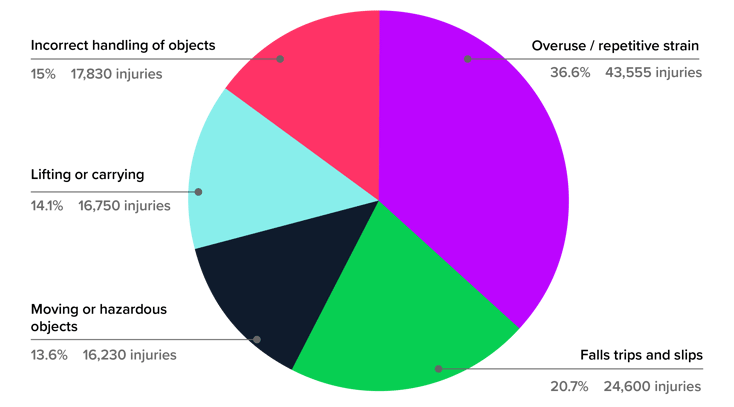The Top 5 Most Common Workplace Injuries in Australia
Posted by Alloc8, Fri, Nov 22, 2019

Every year, tens of thousands of Australians succumb to accidents and become injured at work. Even work environments that are perceived to be lower risk, such as offices, can be unsafe. We've compiled the top five most common workplace injuries, and tips on how to prevent them.
1. Overuse / Repetitive Strain (body stressing) - 43,555 injuries
Body stressing accounts for the most significant number of incidents across Australia. Body stressing is a broad term used to capture all of the different body strains that can be caused by manual tasks, awkward or static positions, repetitive strain, repetitive vibration or excessive noise. Body stressing can include muscle or tissue damage, nerve damage, joint or bone injuries, muscle sprains and strains, or vascular disorders from vibration.
How to avoid it: Asses your current body stress risk and evaluate your workplace for hazards.
2. Falls, trips, and slips - 24,600 injuries
Falls, trips and slips make up the second-highest number of workplace incidents each year. No matter which work environment you are in, you can be prone to falls, trips and slips.
How to avoid it: Ensure you always look where you're going, wear the correct footwear, and report and clean up any spills as soon as they occur.
3. Muscular stress while handling objects - 17,830 injuries
Handling heavy or bulky objects can be a significant cause of muscle stress and strain. While we typically associate handling heavy or bulky objects with lifting ('bend from the knees'), simply reaching for a box that is high up, moving a heavy object on your own or twisting to move something from a shelf while seated can all be the cause of injury. Back, neck and shoulder strain are especially common in these cases.
How to avoid it: Learn and follow correct handling procedures, have the right equipment at hand to carry any objects that are too heavy or large, and if you are unsure, ask for help.
4. Muscular strain while lifting - 16,750 injuries
Despite everything we've been taught, the age old injury from lifting an object still remains as the fourth most common common workplace injury.
How to avoid it: When lifting a heavy or bulky object, ensure you:
a) Do not twist when you lift
b) Do not bend your back when lifting
c) Look straight ahead while carrying the load
d) Keep the load close to your body
e) Know your limits
5. Being hit by moving objects - 16,230 injuries
Being hit by moving objects is not only a common source of injury, but is more alarmingly the second leading cause of workplace fatalities (behind vehicle collision/machinery accidents). Objects falling from shelves, cupboards or other places can cause serious damage. For outdoor workers, there are also other hazards to watch out for including falling branches and flying debris from traffic.
How to avoid it: Always wear the correct protective gear, follow Work Health and Safety practices including completing all checklists, and follow the correct storage and stacking procedures for any goods you work with.
What if I am injured at work?
Employers must display an 'if you are injured at work' poster in every workplace. If you are injured, refer to the poster at your workplace. The general steps following a work injury are:
1. Seek medical treatment
2. Tell your employer
3. Lodge a claim via your state's Work Safe website.
4. Recover at work if you are able to, or plan how to return to suitable work as soon as possible.
Depending on the injury and your employer's insurer, and you may need to make a worker's compensation claim to cover medical expenses and time off work. For specific information relative to your State, visit the Safe Work Australia website.
Prevention is Key
Workplace incidents happen every day, and cost businesses upwards of $60 Billion each year. Not only do workplace injuries harm your workers, but it can also harm your business too. By providing a safe workplace with all of the correct procedures in place, you can remove some of the risk associated with workplace injury.
If you would like to see how Alloc8 can help improve your safety processes and procedures, book a demo with one of our Customer Success Managers today.
Topics: health and safety
